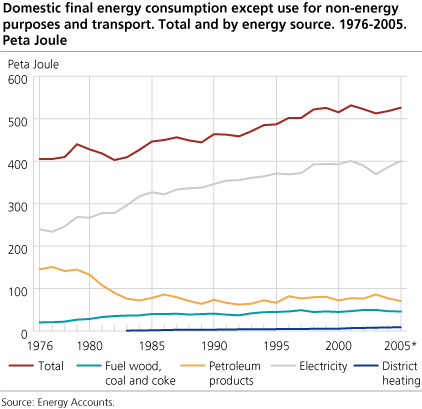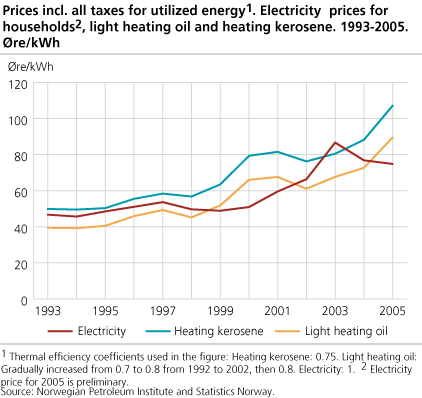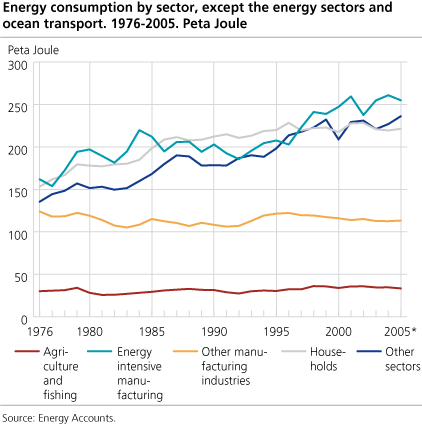Content
Published:
This is an archived release.
Electricity consumption up again in 2005
The electricity consumption rose by 4 per cent in 2005, while the use of heating oils was reduced. This is mainly due to higher prices on oil products, while the electricity prices were slightly reduced compared with the previous year. Total energy consumption in 2005 was 223 TWh, that is 1 per cent more that in 2004.
Electricity has traditionally made up about half of the total end consumption of energy in Norway, and 2005 was not an exception. The consumption of electricity was then 112 TWh. High electricity prices in 2003 and 2004 implied that this consumption fell these years compared with previous years, but the consumption rose again in 2005. Consumption of oil products fell by 1 per cent, but the percentage change from 2004 was different for various oil types. Consumption of oil products for heating purposes and manufacturing industries, as heating kerosene, heating oils and heavy fuel oil, fell by 16-17 per cent compared with 2004. Consumption of kerosene, type jet fuel and diesel rose by 5 per cent, while consumption of marine gas oils rose by 3 per cent. These oil products are mainly used in air- and road transport and coastal shipping. The prices on transport oils also rose in 2005, but this consumption can't be replaced by alternative energy sources and is in small degree affected by price changes. However, it has been a trend towards more use of diesel and less consumption of gasoline the last years, because diesel is cheaper to use.
In this publication, the energy balance and energy account are presented in GWh in addition to the usual tables in Petajoule and physical units (1 TWh = 1000 GWh = 3,6 Petajoule). In addition, a table that shows how much of the energy that comes from renewable energy sources, and one that shows the development of electricity- and energy consumption in different user groups, are presented “included..
Higher energy consumption in services and households
Consumption in services and construction gathered (“other consumers” in the energy balance) rose by 5 per cent from the previous year, while consumption in households rose by approximately 1 per cent from the previous year. The first is due to higher economic activity in services. Growth in energy use in households are mainly due to higher population, but is also affected of temperature, energy prices and income. The average temperature in 2005 was about the same as in 2004, and warmer than normal, according to the Norwegian Meteorological Institute.
. but lower energy consumption in manufacturing industries
According to the energy balance, the energy consumption in manufacturing industries fell by 1 per cent from 2004. This is partly due to a drop in coal and coke consumption on 8.5 per cent. Coal and coke are mainly used as raw materials in the industries.
Almost half of the energy consumption from renewable energy sources
It is a goal in Norway that a constantly higher part of the energy consumption comes from renewable energy sources, as fuel wood, hydro power, wind power and so on. Table 15 shows that 59 per cent of the end consumption of energy came from renewable energy sources in 2005. This is the same as in 1990. If natural gas used in oil and gas extraction is included, the share becomes 46 per cent.
Compared with other countries, a high share of the energy consumption in Norway comes from renewable energy sources. This is because hydro power makes up a large part of the consumption. According to international statistics, the renewable share of Norway’s total energy consumption (including the energy sector) was about 40 per cent in 2004, while the average for OECD was 6 per cent. IEA is the source for these figures, and they use partly different calculation methods than Statistics Norway.
Tables:
- Table 1 Energy sources balance sheet for Norway. 2005
- Table 2 Energy balance sheet for Norway. 2005. Petajoule
- Table 3 Energy balance sheet for Norway. 2005. GWh
- Table 4 Energy accounts. Extraction, conversion and use of energy goods. 2005. Preliminary figures
- Table 5 Energy accounts. Use of energy goods outside the energy sectors, by industry. 2005. Preliminary figures
- Table 6 Energy accounts. Extraction, conversion and use of energy goods. 2005. Preliminary figures. PJ
- Table 7 Energy accounts. Extraction, conversion and use of energy goods. 2005. Preliminary figures. GWh
- Table 8 Energy sources balance sheet for Norway. 2004
- Table 9 Energy balance sheet for Norway. 2004. Petajoule
- Table 10 Energy balance sheet for Norway. 2004. GWh
- Table 11 Energy accounts. Extraction, conversion and use of energy goods. 2004
- Table 12 Energy accounts. Use of energy goods outside the energy sectors, by industry. 2004
- Table 13 Energy accounts. Extraction, conversion and use of energy goods. 2004. PJ
- Table 14 Energy accounts. Extraction, conversion and use of energy goods. 2004. GWh
- Table 15 Energy use in Norway 1990-2005, exclusive international maritime transport and commodities used as raw materials. Renewable and not renewable energy. TWh and per cent
- Table 16 Net consumption of individual energy bearers. 1976-2005
- Table 17 Energi balance sheet. 1994-2005. Petajoule
- Table 18 Percentage share of energy consumption, by individual energy bearers. 1983-2005
- Table 19 Energy consumption in households. 1990-2005
- Table 20 Energy consumption in households. 1990-2005. GWh
- Table 21 Average electricity prices and list prices of selected petroleum products. Excluding and including taxes. 1993-2005
- Table 22 Calculated prices of utilized energy. 1978-2005. Fixed 1998-prices. All taxes included. øre/kWh
- Table 23 Consumption of electricity and total energy consumption by sector, 1990-2005. GWh
The statistics is now published as Production and consumption of energy, energy balance and energy account.
Additional information
The statistics are published in spring and autumn. The spring publication is preliminary and aggregated to a larger degree, and only includes figures for energy balance. In the autumn publication, tables are also presented for the energy accounts.
Contact
-
Statistics Norway's Information Centre
E-mail: informasjon@ssb.no
tel.: (+47) 21 09 46 42



